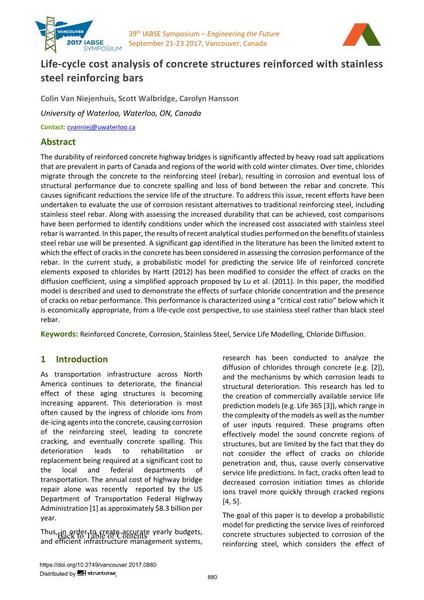Life-cycle cost analysis of concrete structures reinforced with stainless steel reinforcing bars

|
|
|||||||||||
Détails bibliographiques
| Auteur(s): |
Colin Van Niejenhuis
(University of Waterloo, Waterloo, ON, Canada)
Scott Walbridge (University of Waterloo, Waterloo, ON, Canada) Carolyn Hansson (University of Waterloo, Waterloo, ON, Canada) |
||||
|---|---|---|---|---|---|
| Médium: | papier de conférence | ||||
| Langue(s): | anglais | ||||
| Conférence: | IABSE Symposium: Engineering the Future, Vancouver, Canada, 21-23 September 2017 | ||||
| Publié dans: | IABSE Symposium Vancouver 2017 | ||||
|
|||||
| Page(s): | 880-887 | ||||
| Nombre total de pages (du PDF): | 8 | ||||
| Année: | 2017 | ||||
| DOI: | 10.2749/vancouver.2017.0880 | ||||
| Abstrait: |
The durability of reinforced concrete highway bridges is significantly affected by heavy road salt applications that are prevalent in parts of Canada and regions of the world with cold winter climates. Over time, chlorides migrate through the concrete to the reinforcing steel (rebar), resulting in corrosion and eventual loss of structural performance due to concrete spalling and loss of bond between the rebar and concrete. This causes significant reductions the service life of the structure. To address this issue, recent efforts have been undertaken to evaluate the use of corrosion resistant alternatives to traditional reinforcing steel, including stainless steel rebar. Along with assessing the increased durability that can be achieved, cost comparisons have been performed to identify conditions under which the increased cost associated with stainless steel rebar is warranted. In this paper, the results of recent analytical studies performed on the benefits of stainless steel rebar use will be presented. A significant gap identified in the literature has been the limited extent to which the effect of cracks in the concrete has been considered in assessing the corrosion performance of the rebar. In the current study, a probabilistic model for predicting the service life of reinforced concrete elements exposed to chlorides by Hartt (2012) has been modified to consider the effect of cracks on the diffusion coefficient, using a simplified approach proposed by Lu et al. (2011). In this paper, the modified model is described and used to demonstrate the effects of surface chloride concentration and the presence of cracks on rebar performance. This performance is characterized using a “critical cost ratio” below which it is economically appropriate, from a life-cycle cost perspective, to use stainless steel rather than black steel rebar. |
||||
| Mots-clé: |
acier inoxydable
|
||||
